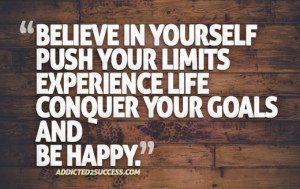Motivation
The Ultimate Guide To Recognizing And Conquering Crippling Beliefs

Do you know that feeling?
That urge calling you to do better. To establish firm goals and go after each in a predestined, unfaltering and decisive manner.
But something holds you back.
You can’t quite put your finger on it, yet something inside you is stopping you from manifesting the greatest version of yourself.
And while working out this problem, life is passing you by.
But it isn’t your fault.
Schools, parents, and peers don’t teach you the inner workings of the mind — the device responsible for your most spectacular successes and ugliest failures.
You see, most often than not, the way you think about things is the root cause of your unhappiness.
The biggest liar in the world
Your mind is undoubtedly brilliant. Though it has a dark side.
Whispering in your ear, moment after moment, telling you things you wouldn’t even tolerate from your worst enemy.
It can behave like a paranoid schizophrenic, convincing you that everyone is out to get you, you’re not good enough and you must change who you are to fit in.
To top it off, all the proof is there of your inadequacy. You find it difficult to connect with people, you’re in a job that sucks and you keep making silly mistakes over and over again. Sure signs of failure.
There comes a point when you can no longer separate yourself from these “truths” – you are one with your beliefs. That’s when you stop trying to make meaningful change in your life.
But listening to your mind is like living with a liar. The internal chatter becomes so overpowering, it’s almost impossible to recognize that thoughts are only words the mind strings together at any given moment.
The good news? It’s never too late to cut through the fog, flip your unhelpful beliefs and create a life of success.
“If one can only see things according to one’s own belief system, one is destined to become virtually deaf, dumb and blind.” – Robert Anton Wilson
Canny ways to uncover your limiting beliefs:
- What’s your body telling you? What thoughts go through your mind when you have tension in your stomach? Your mind and body are connected, and even when your mind blinds you, your body will be a better place to look for answers. I had stomach pains for many years, but I accepted them as part of being anxious most of the time. Had I listened to my stomach earlier, I could’ve explored the reasons behind the constant churning.
- What do you avoid? Things that you’re afraid to do can point to your stubborn, unhelpful beliefs. I don’t mean you have to jump off a bridge with a rope attached to your legs if you’re terrified of heights – though you could try that too. What I’m saying is that you habitually stop doing things you think are hard. Maybe you’re asked to give a presentation and your immediate reaction is to refuse it. Go in and explore why you reject this. Often what you most avoid is what you should be doing to progress.
- Who offends you and why? People who hurt you can act like a mirror giving a glimpse into underlying beliefs you hold tight. Your friends will rarely point out your blind spots. I’m not suggesting the offenders are right; instead, think of those as areas where you can make improvements in your attitude. It doesn’t help you to be angry and bottle up emotions against someone else. These emotions can indicate that you need to ease up some feelings when someone says the wrong thing to you. Your anger won’t hurt them. It only harms you.
- Can you stare at a wall … and do nothing? Most people are unable to do it for long (unless they’re experienced monks). I guarantee, even before 10 seconds pass your mind will jump into as many different ideas, worries and concerns. Which is an ideal opportunity for taking note of the chain of thoughts your mind created in that short time. And most of those sub-conscious thoughts will have an unpleasant undertone as studies have shown, because that’s the way minds work. So don’t be surprised of what you uncover.

The art of taming unhelpful beliefs:
So you now have some ideas about what those negative beliefs are, but how do you get rid of them? You don’t actually have to. It’s enough to turn the volume down on them to lessen their power over you.
- Say, “Hello.” Receive your negative thoughts, beliefs and feelings with open arms instead of fighting them. Acceptance does not equal defeat. It’s more like a friendly acknowledgement. Once you’re better at recognizing your thoughts and beliefs, you can give them a little nod, as if to say, “Yes, I can see you’re there.” But they don’t have to bother you.
- Don’t take them seriously. You can try not taking negative blabber seriously. Since laughter is the best form of medicine, do what it takes to ridicule them. Repeat troubling phrases in your head in a funny voice (Yoda is my favorite). Or try recording your most intrusive phrase, like “I’m not good enough” for about five minutes to a recording device. Then re-listen – if you can bear it for that long, you’ll understand that these are merely harmless words repeated over and over again.
- Join a community. Find a support group (online or off) – the type of people whom you aspire to be. They’ll soon make you realize that your most precious beliefs could be just fantasies. They’ve been through where you are now and know the shortcuts to overcoming your problems. They’ll inspire you and show you how to thrive in your skin. There’s no easier way to grow than by taking advantage of the power of an experienced group.
“Limits, like fear, is often an illusion” – Michael Jordan
Transforming the noise into action
Your mind will always try and trip you up, no matter how self-developed you are. That’s the nature of minds.
But you can outsmart it by staying one step ahead and understanding its workings.
Every day, you have oodles of chances to acquaint yourself with the real meaning behind your sub-conscious thoughts.
Knowing how to catch the unhelpful chatter and turn them into a source of power will help you fling into the orbit of change and onto a rich life that’s worth living.
And there isn’t a more ideal day than today – so you’d better get started.
Did You Know
7 Surprising Life Lessons Video Games Taught Me That School Never Did
Want to get better at something? Study the pros. That applies to both life and video games

If you play video games, you’ll quickly discover you’re not alone. You’ll meet people who share your interests, challenge your skills, and even teach you something new about yourself. I started gaming when I was 10. A classmate invited me to play after school, and I was hooked. (more…)
Featured
The Psychology of Motivation: How to Keep Moving Forward Every Day
Discover how daily habits, self-discipline, and a few clever strategies can spark your drive and focus.

You wake up on a typical Monday morning, glance at your clock, and realize it’s time to get moving. How do you summon that inner drive to deal with your responsibilities with a genuine smile on your face? (more…)
Motivation
From Couch Potato to Go-Getter: A Step-by-Step Motivation Plan for Everyone
By understanding what motivates you, you can turn your dreams into reality

Are you tired of feeling like a couch potato? Do you want to transform your life and become a go-getter? You’re not alone! Many people struggle with motivation, but the good news is that change is possible. (more…)
Motivation
Why You’re Failing to Achieve Your Goals and How to Fix It Now
Understanding motivation is crucial because it’s the cornerstone of success

Feeling stuck? Lost in a sea of goals, but lacking the drive to pursue them? It’s time to shift gears and reignite your motivation! Picture this: From stalled to soaring, your journey awaits. (more…)
-

 Success Advice4 weeks ago
Success Advice4 weeks agoThe One Mindset Shift That Made Me Irreplaceable At Work
-

 Did You Know3 weeks ago
Did You Know3 weeks ago7 Surprising Life Lessons Video Games Taught Me That School Never Did
-

 Success Advice3 weeks ago
Success Advice3 weeks agoHow Playing by the Rules Became the Smartest Business Strategy
-

 Success Advice3 weeks ago
Success Advice3 weeks agoHow to Build Trust, Kill Micromanagement, and Lead a Team That Thrives
-

 Scale Your Business3 weeks ago
Scale Your Business3 weeks agoHow to Build a Workplace People Actually Want to Show Up To
-

 Success Advice2 weeks ago
Success Advice2 weeks agoSuccess Isn’t Sexy: 5 Daily Habits That Actually Work
-

 Scale Your Business2 weeks ago
Scale Your Business2 weeks agoHow Smart Entrepreneurs Cut Financial Chaos in Half with One Simple Switch
-

 Success Advice2 weeks ago
Success Advice2 weeks agoBreaking the Bias: How Females Can Thrive In The Workplace in 2025






























28 Comments